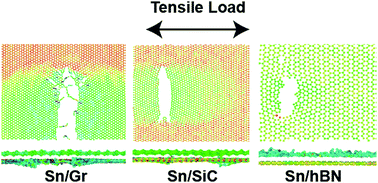Characterization of the mechanical properties of van der Waals heterostructures of stanene adsorbed on graphene, hexagonal boron–nitride and silicon carbide†
Abstract
Stanene has revealed a new horizon in the field of quantum condensed matter and energy conversion devices but its significantly lower tensile strength limits its further applications and effective operation in these nanodevices. Van der Waals heterostructures have given substantial flexibility to integrate different two-dimensional (2D) layered materials over the past few years and have proven highly functional with exceptional features, appealing applications, and innovative physics. Considerable efforts have been made for the preparation, thorough understanding, and applications of van der Waals heterostructures in the fields of electronics and optoelectronics. In this paper, we have executed Molecular Dynamics (MD) simulations to predict the tensile strength of van der Waals heterostructures of stanene (Sn) adsorbed on graphene (Gr), hexagonal boron nitride (hBN), and silicon carbide (SiC) (Sn/Gr, Sn/hBN, and Sn/SiC, respectively) subjected to both armchair and zigzag directional loading at different strain rates for the first time, which has enticing applications in electronic, optoelectronic, energy storage and bio-engineered devices. Among all the van der Waals heterostructures, the Sn/SiC heterostructure exhibits the lowest tensile strength and tensile strain. Furthermore, it has been found that zigzag directional loading could endure more tensile strain before fracture. Besides, it has been disclosed that though the rule of mixtures may accurately reproduce the Young's modulus of these heterostructures, it has limitations to predict the tensile strength. Fracture analysis suggests that for the Sn/hBN heterostructure the fracture initiates from the stanene layer while for the Sn/Gr and Sn/SiC heterostructures the fracture initiates from the Gr and SiC layer, respectively, for both armchair and zigzag directional loading. Overall, this study would aid in the design and efficient operation of Sn/Gr, Sn/hBN, and Sn/SiC heterostructures when subjected to mechanical force.

- This article is part of the themed collection: 2021 PCCP HOT Articles


 Please wait while we load your content...
Please wait while we load your content...